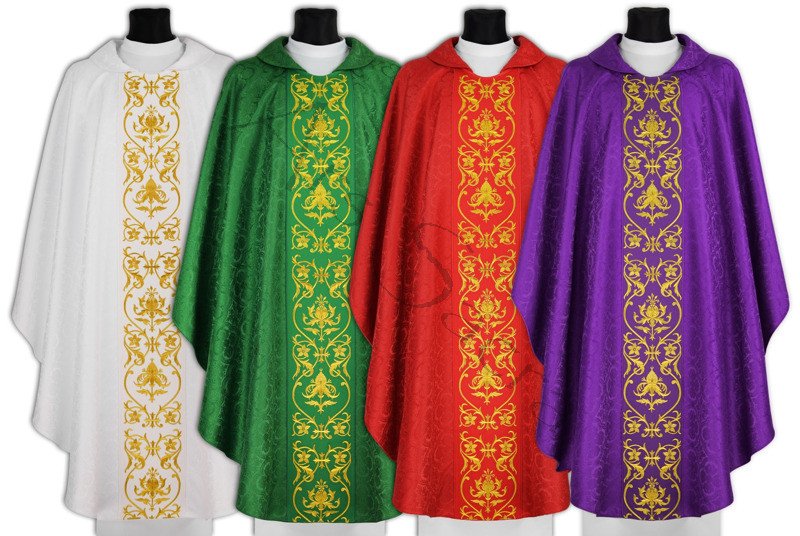When you step into a place of worship, the atmosphere is often enhanced by the colorful and intricate garments worn by clergy members. Among these sacred garments, Class A vestments stand out as symbols of reverence and tradition. But what exactly are Class A vestments? From their origins to their significance in religious ceremonies, these garments carry deep meaning that transcends mere fabric.
In this exploration, we will delve into the history, types, materials, and symbolism behind Class A vestments. Whether you’re a member of the clergy or simply curious about liturgical attire, understanding these elements can enrich your appreciation for this vibrant aspect of faith traditions. Join us on this journey to uncover what makes Class A vestments so special!
History and Significance of Class A Vestments
The history of Class A vestments can be traced back to the early Christian church. As Christianity spread, so did the need for distinctive clothing that signified clergy roles. These garments became a symbol of faith and authority.
Class A vestments gained prominence through various liturgical traditions. They were often adorned with rich fabrics and intricate designs, reflecting both religious significance and cultural artistry.
Over time, these vestments evolved in style but maintained their core purpose: to set apart the clergy during worship services. The vibrant colors used corresponded with different liturgical seasons, enhancing the overall spiritual experience for congregants.
Their significance extends beyond aesthetics; they embody centuries of tradition, representing continuity within the church community. Wearing these garments is an act of devotion as much as it is a display of ecclesiastical dignity.
Types of Class A Vestments:
Class A vestments come in various forms, each with its own purpose and significance. The chasuble is a flowing outer garment worn by priests during the Eucharist. Its colors often reflect the liturgical calendar, embodying spiritual meaning.
The stole, a narrow strip of cloth, hangs around the neck and signifies authority and service. It’s an essential symbol for clergy members performing sacraments.
An alb is a long white robe that represents purity. Worn beneath other vestments, it serves as a reminder of baptismal vows.
The dalmatic features wide sleeves and is typically worn by deacons during worship services. This vestment symbolizes joy in serving others.
The cope is a cape-like garment used for processions or special occasions. Its elegance adds to solemnity while reinforcing tradition within worship settings. Each piece plays an integral role in enhancing the spiritual experience.
A. Chasuble
The chasuble is perhaps the most iconic piece of Class A vestments. Traditionally worn by priests during Mass, it drapes gracefully over the shoulders and falls to varying lengths. Its flowing design adds an air of elegance and reverence to liturgical celebrations.
Chasubles come in a range of colors, each representing different seasons or occasions within the church calendar. From deep purple for Advent to vibrant red for Pentecost, these hues carry significant meanings that enhance worship experiences.
Crafted from rich fabrics like silk or brocade, chasubles often feature intricate designs and embroidery. This artistry not only reflects spirituality but also showcases the skill of artisans who create them.
When worn correctly, a chasuble serves as both a symbol of authority and humility. It reminds clergy members they are conduits between God and their congregation while embodying grace in every gesture made during service.
B. Stole
The stole is a distinctive piece of liturgical attire worn by clergy, symbolizing their ordained ministry. This long, narrow strip of fabric drapes elegantly around the neck and falls down the front. Its design can vary significantly across different denominations.
Traditionally, the stole is worn over an alb or chasuble during services. The color often corresponds to the liturgical calendar—green for ordinary time, purple for Lent and Advent, and white or gold for celebrations like Easter and Christmas.
Beyond aesthetics, it has deep spiritual significance. Wearing a stole represents the authority bestowed upon clergy members to serve their congregation. It acts as a visual reminder of their commitment to lead in faith and compassion while carrying out sacred duties within worship settings.
C. Alb
The alb is a long, white garment that symbolizes purity and holiness. Traditionally worn by clergy during liturgical services, it has deep roots in Christian history.
Typically made of linen or cotton, the alb falls to the ankles and features wide sleeves. Its simplicity underscores the focus on spiritual service rather than personal adornment.
The alb is often paired with a cincture—a rope belt that secures it at the waist—adding an element of practicality to its elegant design. This combination not only enhances appearance but also allows for ease of movement during worship.
Many congregations choose to personalize their albs with embroidery or decorative elements specific to their traditions. Such details can reflect theological significance or community identity while retaining the garment’s essential purpose: serving as a reminder of Christ’s righteousness and grace in ministry.
D. Dalmatic
The dalmatic is a distinctive vestment, easily recognized by its wide sleeves and elegant design. Traditionally worn by deacons during liturgical services, it signifies their role in the Church. The shape allows for ease of movement while conveying a sense of dignity.
Crafted from rich fabrics, dalmatics often feature intricate embroidery or patterns that reflect the occasion’s significance. They come in various colors to correspond with different liturgical seasons—think vibrant greens for Ordinary Time or deep purples for Lent.
Wearing a dalmatic not only enhances the visual aspect of worship but also serves as a reminder of service and humility. Its flowing style embodies grace, inviting congregants to focus on the spiritual message rather than mere ritual formality. This delicate balance makes the dalmatic an essential piece within Class A vestments, contributing meaningfully to any religious ceremony.
E. Cope
The cope is a distinctive vestment often worn during processions and special liturgical events. It resembles a cape, flowing elegantly from the shoulders to the feet.
Traditionally, it is made of rich fabric adorned with intricate designs or embroidery. This embellishment reflects the sacredness of the occasion and enhances its visual appeal.
Unlike many other vestments, a cope does not have sleeves. Instead, it features an opening at the front for ease of wear while maintaining a dignified appearance.
Typically fastened at the neck with a clasp or brooch, this garment allows for comfortable movement without sacrificing style.
In many Christian traditions, wearing a cope signifies reverence and solemnity during worship services. Its usage adds an element of grandeur that elevates the spiritual experience for both clergy and congregation alike.
Materials Used in Class A Vestments
Class A vestments are crafted from various materials, each chosen for its beauty and significance. Silk is a popular choice due to its luxurious feel and vibrant colors. It drapes elegantly, making it perfect for ceremonial occasions.
Cotton blends also find their place in these garments. They offer durability while maintaining comfort, making them suitable for regular use by clergy members.
Wool is another material used, especially in colder climates. Its warmth provides both practicality and tradition during services held in chillier months.
Some vestments incorporate intricate embroidery or embellishments that add texture and depth to the piece. These details often reflect specific themes or liturgical seasons, enhancing visual storytelling within the church setting.
Moreover, synthetic fabrics have emerged as alternatives that combine ease of care with affordability without compromising on aesthetic appeal. Each fabric plays a role in conveying the sacredness associated with Class A vestments.
Symbolism and Meaning Behind Class A Vestments
Class A vestments carry profound symbolism that transcends mere garments. Each piece serves a specific purpose in liturgical celebrations, embodying aspects of faith and tradition.
The chasuble, often richly adorned, symbolizes the yoke of Christ. It represents the priest’s role as a servant leader within the church community.
Stoles convey authority and are worn over the shoulders, indicating the responsibility held by clergy members. Their colors vary according to liturgical seasons, reflecting different themes in worship.
The alb signifies purity and baptismal grace, reminding both clergy and congregation of their call to holiness.
Dalmatic robes signify joy and festivity during special occasions or sacraments. They serve as visual reminders of celebration within spiritual life.
Copes add an air of dignity to processions while symbolizing God’s protection enveloping His people throughout their journey together in faith. Each element weaves a rich tapestry steeped in spiritual significance.
How to Properly Wear and Care for Class A Vestments
Wearing Class A vestments requires attention to detail. Begin by ensuring the garments are clean and pressed. This enhances their appearance during services.
When putting on a chasuble, start with the stole draped around your neck. Then, slip into the chasuble over your shoulders. Adjust it so it falls evenly for comfort and dignity.
Caring for these sacred garments is equally important. Store them in a cool, dry place away from direct sunlight to prevent fading. Regularly check for any signs of wear or damage.
For cleaning, follow specific care instructions based on fabric type; gentle hand-washing is often preferable. Avoid harsh detergents that can degrade materials over time.
Always handle vestments with reverence and respect, as they hold deep spiritual significance within the church community.
Controvers
Controversy surrounding Class A vestments often stems from their symbolism and historical associations. Some argue that these garments can represent outdated traditions in a contemporary world striving for simplicity.
Critics may view the ornate nature of these vestments as excessive, especially when many congregations seek to focus on spiritual connection rather than appearance.
On the other hand, proponents firmly believe that such attire elevates worship by creating an atmosphere of reverence and awe. They see the rich history embedded in each piece as essential to maintaining a link with centuries of faith practice.
Discussions about inclusivity also arise; some denominations are reevaluating how traditional garments fit into modern values regarding representation and accessibility within worship spaces.
These debates reflect broader themes in religious communities, highlighting the ongoing tension between tradition and evolution within faith practices.
FAQs
What are Class A vestments?
Class A vestments refer to the formal attire worn by clergy during significant liturgical celebrations. These garments are characterized by their rich symbolism and ceremonial importance, often reserved for special occasions like Easter or Christmas.
Why is it important to wear Class A vestments?
Wearing Class A vestments helps in setting a sacred tone for worship. They signify the dignity of the role and remind both clergy and congregation of the spiritual significance of the service.
Can anyone wear Class A vestments?
Typically, only ordained ministers or those involved in specific liturgical roles wear these garments. They represent authority within the church context and connect directly with tradition.
How do I care for my Class A vestments?
Proper care depends on materials used but generally includes gentle washing or dry cleaning, storing them in a cool, dry place away from direct sunlight, and ensuring they’re free from creases before wearing.
Are there different colors for Class A vestments?
Yes! Colors vary according to liturgical seasons—purple for Advent and Lent, white for Easter and Christmas, red for Pentecost, green during Ordinary Time—and serve as visual cues to enhance worship experiences.
Do all denominations use Class A vestments?
While many Christian denominations utilize some form of formal clergy attire akin to Class A vestments—such as Catholicism, Anglicanism, Lutheranism—not all traditions adhere strictly to this practice. Variations exist based on denominational customs.
Understanding these aspects can deepen one’s appreciation not just for the garments themselves but also their profound connection to faith practices throughout history.

















